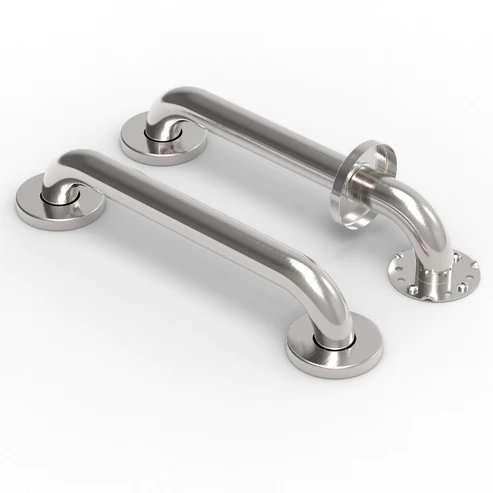When it comes to home design, accessibility is often overlooked. Yet, making your home more accessible is not only wise for aging-in-place plans, but it also creates a welcoming environment for all individuals, including those with mobility limitations. Whether you’re looking for a complete aging-in-place style remodel or just looking to fix inaccessible problem areas in your home, installing grab bars and handrails is one of the most effective ways to make your home more accessible and safe. This article will explore the importance of accessible remodels, the benefits of grab bars and handrails, different types of grab bars and handrails, installation tips, and cost considerations. We will also highlight some of the best grab bars and handrails for accessibility and provide tips for maintenance and repair.
Introduction to Accessible Remodels
If you’re considering a home remodel, it’s important to keep accessibility in mind. An accessible remodel is a renovation that improves a home’s accessibility for those with physical disabilities or limitations. These types of remodels can include wider doorways, lower cabinets, and more accessible bathrooms. In this article, we’ll focus on one of the most important aspects of an accessible remodel: grab bars and handrails.
What is CAPS / Aging In Place Remodeling?
An accessible remodel is a renovation that makes a home more accessible and easier to navigate for individuals with physical disabilities or limitations. These types of remodels can range from minor adjustments like adding handrails to more extensive renovations like installing wheelchair ramps or creating a fully accessible bathroom.
The CAPS program focuses on creating safe and accessible living environments for seniors by remodeling their homes to meet their changing needs. CAPS remodels involve a comprehensive evaluation of the home, identifying potential hazards or barriers that may hinder mobility and independence.
Why is Accessibility Important?
Accessibility is important because it promotes independence and a higher quality of life for individuals with physical disabilities or limitations. An accessible home allows individuals to move around with ease and to complete daily tasks without assistance. It can also prevent accidents and injuries, which can be especially important for elderly individuals or those with limited mobility. Remodeling with accessibility in mind, especially with a Certified Aging In Place Specialist can ensure you or your loved ones can continue to live at home, and is often a cheaper option than assisted living or an in-home aide.
Importance of Grab Bars and Handrails
When it comes to accessibility in a home, one of the most important features is grab bars and handrails. These simple additions can make a big difference in a person’s ability to navigate their home with ease.
Grab bars and handrails provide support and stability for individuals with physical disabilities or limitations. They can help prevent falls and make it easier to transfer from one location to another. They are especially important in bathrooms and stairs, where slips and falls are more likely to occur. Installing grab bars and handrails in your home can provide numerous benefits, including increased safety, improved accessibility, and greater independence. They can also be customized to fit your specific needs and preferences.
Types of Grab Bars and Handrails
There are several different types of grab bars and handrails to choose from, each with its own unique features and benefits.
- Straight Grab Bars: Straight grab bars are the most common type of grab bar. They are typically installed in bathrooms and next to stairs to provide support and stability.
- Angled Grab Bars: Angled grab bars are designed to provide support at an angle, which can be helpful for individuals with limited upper-body strength or mobility.
- Folding Grab Bars: Folding grab bars are a great option for smaller spaces where a permanent grab bar would be inconvenient. They can be folded out of the way when not in use.
- Handrails: Handrails are typically installed along staircases to provide support and stability while going up or down stairs. They can also be installed in hallways to provide additional support.
Installation Tips for Grab Bars and Handrails
When installing grab bars and handrails, there are a few important things to keep in mind to ensure they are safe and effective.
- Choosing the Right Location: The location of your grab bars and handrails is critical. They should be installed in areas where support is needed the most, such as next to toilets, in shower stalls, and along staircases.
- Proper Height and Placement: The height and placement of your grab bars and handrails is also important. They should be installed at a height that is comfortable for you to use, and they should be placed in a location that is easy to reach.
- Installation Techniques: Finally, it’s important to use the proper installation techniques when installing grab bars and handrails. They should be securely anchored to the wall or floor to ensure they can support weight and provide stability. It’s also important to follow the manufacturer’s instructions carefully to ensure proper installation.
Best Grab Bars and Handrails for Accessibility
Top-rated Grab Bars and Handrails for Safety and Comfort
When it comes to accessible remodels, grab bars and handrails are crucial for maintaining safety and independence. Here are some of the best grab bars and handrails on the market:

Moen LR8724D3GBN Home Care 24-Inch Grab Bar
This grab bar has a maximum weight capacity of 500 pounds and comes with either a brushed nickel, chrome, or bronze finish that can be matched to any bathroom decor.

AmeriLuck Stainless Steel Bath Grab Bar
This grab bar is made with durable stainless steel and has a non-slip surface for added safety. With a load tolerance of 500lbs, it’s also corrosion-resistant, making it ideal for use in bathrooms.

Franklin Brass Concealed Mount Safety Bath and Shower Grab Bar
These grab bars come in a variety of configurations and feature concealed mounts for a seamless appearance. They also meet the 500lb ADA standard for weight.
View on Amazon
Grab Bars and Handrails for Different Parts of the Home
- Stair railings: Handrails for stairs should be sturdy and should extend past the top and bottom steps for added safety. Consider using wall-mounted handrails or attaching handrails to the stair treads themselves.
- Entryways: Installing a grab bar or handrail near the entryway of your home can help you maintain balance when entering or exiting the home. Look for grab bars that can be easily installed into the wall or onto the door frame.
- Shower stalls: Handrails and grab bars in shower stalls can help prevent slips and falls. Consider installing grab bars vertically and horizontally for added support.
Cost Considerations for Grab Bars and Handrails
Accessibility modifications can be costly, but grab bars and handrails are often one of the most affordable options. Here are some factors that can affect the cost of grab bars and handrails:
- Material: Grab bars and handrails can be made from various materials, such as stainless steel or chrome. The material you choose can affect the cost.
- Length: Longer grab bars and handrails tend to cost more than shorter ones.
- Installation: If you hire a professional to install your grab bars and handrails, the cost may go up.
Maintenance and Repair of Grab Bars and Handrails
Proper maintenance can help extend the life of your grab bars and handrails. Here’s how to keep them in good condition:
How to Maintain Grab Bars and Handrails
- Clean them regularly: Use a non-abrasive cleaner and a soft cloth to clean your grab bars and handrails.
- Check for wear and tear: Regularly inspect your grab bars and handrails for signs of wear and tear.
Common Issues and How to Repair Them
- Loose screws: Use a screwdriver to tighten any loose screws.
- Rust: Use a rust remover and a soft cloth to remove any rust from your grab bars and handrails.
When it comes to accessible remodels, it’s essential to prioritize grab bars and handrails for safety and independence. Choose the right grab bars and handrails for your specific needs, factor in cost considerations, and properly maintain them for maximum longevity.
In conclusion, installing grab bars and handrails is a simple and effective way to make your home more accessible and safe for all individuals. With the variety of options available, you can choose the best grab bars and handrails that suit your needs and budget. Remember to follow installation instructions carefully and to maintain your grab bars and handrails regularly. By making these changes, you can create a more welcoming home that promotes independence, safety, and peace of mind.







